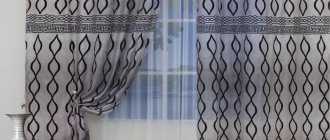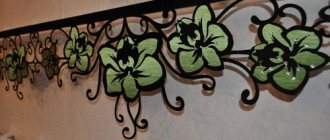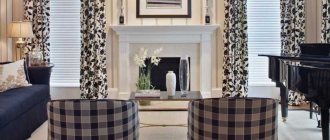What is macrame
Macrame is a well-known and popular all over the world method of needlework, the so-called knot weaving. Its essence lies in the fact that knots of different types and sizes are tied on a cord or thick yarn, in a certain sequence, and the result is the pattern you want.
Among the techniques that demonstrate the refinement of taste and skill of the needlewoman is macrame weaving.
Modern techniques have come to us from Ancient China, and mastering macrame is not as difficult as it might seem at first glance. As a result, the curtains turn out to be so spectacular that it is literally impossible to take your eyes off them. The main advantage is that you always have room for imagination, and no one forbids you to embody your own ideas.
Using the macrame technique, you can weave a huge number of original interior items, one of which is a curtain.
The main requirement for the material: the rope must be smooth and dense, and thickness, in the end, does not matter.
The rope can be nylon, cotton, hemp or other raw materials.
Macrame. Curtains in the interior. Description of weaving
Hello, dear visitor!
Last time I posted pictures of curtains and showed how you can use wicker curtains in the interior of your home. See here for more details.
Today I found a description of weaving curtains in M. Kuzmina’s book “The ABC of Weaving”, second edition, 1992. It is my pleasure to offer you the opportunity to weave the same curtains. Not only for yourself, but also to order, for gifts and sale.
Curtain size 60*200 cm. For work you will need 950 m of hemp rope 3mm thick, wooden balls - 31 pcs. and a durable metal strip 60 cm long.
1. Cut 50 threads of 18 meters each, fold each in half and secure using method 3 on a strong strip - you get 100 threads of 9 meters each.
2. Set aside 2 threads from the edges and distribute the rest into 6 groups, 16 threads each. now complete the 1st row of the pattern. To do this, weave the corners of each group
two located diagonally (see Fig. 1) First, tie 1 knot under the bar on 7,8,9 and 10 threads, counting from left to right. Make the next 2 knots in a checkerboard pattern, using 2 free threads on the right and left. Weave 3 knots on each side. Connect adjacent corners with a double flat knot, using 2 threads from the last weaving knots. In the 1st and 6th groups, tie the outermost knots, taking 2 previously set aside threads. On the 4 middle threads between adjacent corners, make chains of 5 double flat knots, tying them at a distance of 0.5 cm from each other. Step back down 1.5 cm and weave the corners of 5 knots on 12 free threads at 1, 3 and 5 angles. After 4 cm, make corners on the same threads in a mirror image and after another 1.5 cm, finish the 1, 3 and 5th fragments with large corners of 7 knots.
3. On 12 free threads at 2, 4 and 6 angles, make an openwork chain with rings (see Fig. 2 and Fig. 3). First, tie 1 double flat knot on the middle 4 threads and pull the 2 outer threads away from it. Tie the next knot with 2 new threads on the 2 middle threads from the previous knot and pull the outer threads to the sides. Do 3 more knots in the same way. Then thread a ball through the 2 middle threads and tie 5 knots under it in the same way as the top ones. Rings formed along the edges of the chain. Finish these fragments with corners of 7 knots.
4. Start the 2nd row of the pattern 2 cm below the 1st. Weave it in the form of diamonds, consisting of 11 rows of double flat knots in a checkerboard pattern. The number of nodes in the rows is as follows: 1,2,3,4,3,4,3,4,3,2,1. In total you will get 5 whole diamonds of 16 threads and half a diamond of 10 threads from the edges of the fabric. Do not connect adjacent rhombuses. Stepping back 2 cm from the 2nd row, weave the 3rd row of the pattern, repeating the work described in the 1st row (see step 2). The only difference is in the order of the fragments: in fragments 1, 3 and 5, weave openwork chains with balls.
5. Complete 6 more rows of the pattern, alternating fragments of the 1st and 2nd row. When weaving the 2nd row, change the location of the fragments with balls.
6. Set aside 10 threads from the edges and for every 16 free mm between the fragments of the last row, make diamond shapes from double flat knots in a checkerboard pattern. The number of nodes in the rows is as follows: 1,2,3,4,3,2,1. On 10 threads set aside from the edges, weave half of such a rhombus, arranging the knots in rows like this: 1,1,2,2,2,1,1.
7. On the middle 4 threads between adjacent diamonds (including the halves of the diamonds from the edges), tie 1 flat knot, then thread 2 middle threads into the ball and secure it with 1 flat knot. After this, place 2 ends on top of each other under this knot and throw 12 threads 1 m long through them - thinner ones if possible. (see Fig. 4). Align the threads in length and secure the resulting brush with a “braid”. Make 6 of these brushes.
8. On the 8 outer threads on the right and left, weave 13 rows (15 cm) of chains of double flat knots, alternating 1 and 2 knots in rows. Finish the weaving with 2 knots, place 4 threads on top of each other and throw 10 additional 70 cm threads through them. Secure the brush with a “braid”.
9. On loose threads (12 each) under the diamonds, make 5 openwork chains (see Fig. 5). Weave 4 balls into the middle chain with an interval of 5 double flat knots, into the next 2 – 2 balls with the same interval and in the outer chains fasten only 1 ball. Finish each chain with a brush, tightening it with a “braid”. Steam the product on a soft mat through 2 layers of wet gauze.
Figure 2. Scheme of weaving an openwork chain of triple rings
Figure 3. Triple ring chain.
Figures 1, 4 and 5 will be inserted shortly. They are in weaving and processing.
Where to begin
If this type of needlework interests you, and you can’t wait to create “something like that,” first, familiarize yourself with the main types of macrame knots. There are few of them, and mastering them will not take you much time. Now you need to decide on the size of the future curtain and its pattern (diagram).
Products made using this method can decorate any interior, and you can even learn how to do it yourself.
You can start choosing the material. For beginners, it is better to avoid smooth, slippery ropes, since even skilled craftsmen have difficulty working with such material: the knot is difficult to fix and requires constant effort and control over compliance with the chosen pattern. But paper twine and a regular clothesline are an ideal option for a beginner.
Some time ago, knot weaving was undeservedly forgotten, but today it is experiencing a rebirth.
The main requirement for the material: it must be strong and elastic enough to securely fix the knot and prevent it from loosening or untying.
If you decide to start working with synthetic cord, then remember that the main disadvantage of this material is unraveling at the cut point, so do not forget to melt the edge.
With the help of macrame they make things of amazing beauty and elegance that will add originality and originality to any interior.
As a rule, it is difficult for novice craftsmen to immediately determine the amount of material needed, so it is recommended to purchase rope with a small reserve. Also, make sure you have the necessary equipment and tools, and don’t forget about decorative elements such as buttons, small appliqués, lace or ruffles.
In order to make beautiful macrame curtains, you don’t have to buy expensive fabric. They can be made from the simplest and completely inexpensive materials.
Required accessories:
- Centimeter, ruler for measurement;
- Scissors;
- Pins for fixation;
- Regular needles for sewing on decor;
- Crochet hook (often required if you need to untie an incorrect knot);
- Glue for fixing special units;
- A thick pad for attaching threads (some people prefer to use a special wooden frame for this purpose).
For the most comfortable work, any filler is fixed to a wooden base and sheathed with durable material. If the “upholstery” is checkered, this will significantly simplify the work process. If you choose a round pattern, then you can use a hoop as a base.
Almost any thread, twine or rope is suitable for weaving curtains. The main thing is that they have a high degree of curl, otherwise the pattern will not come out clear and prominent.
This is the most necessary, but the set of accessories may be slightly supplemented depending on the model and material you choose.
Materials needed for weaving macrame curtains with your own hands
The main materials for making any product using the macrame technique are threads and cords. The appearance and quality of the craft largely depend on their choice. Almost any thread is suitable for weaving curtains, the main thing is that they have a high degree of twist, otherwise the pattern will not be clear and prominent enough. For beginners in macrame, it is better to choose a material consisting of cotton, linen or wool fibers as it is easier to work with.
Curtains made of silk threads and gold thread look more elegant and expensive, but such ropes are more slippery, so tying knots with them requires some skill.
If you have threads at home, but they are too soft or too hard, this problem can be easily corrected. A product made from a material that has irregularities can also be given a more neat appearance.
How to improve the condition of the threads:
- Hard threads can be softened by holding them over hot steam for five minutes. This processing method will not damage the structure or deteriorate the appearance of the threads, so you can safely use it.
- To give the threads additional rigidity, they need to be kept in a gelatin solution for some time, and then dried in a suspended state. The gelatin solution is made as follows: pour 5 liters into a container. water at room temperature and pour in 50 g of gelatin, after swelling of which, the mixture must be heated in a water bath, then mixed with a teaspoon of glycerin and 2 liters. boiling water
- To give a more neat appearance to uneven threads, after weaving the product, it needs to be ironed with a hot iron through several layers of gauze.
Advantages and disadvantages of macrame curtains
Advantages
To be fair, it is worth noting that macrame curtains compare favorably with other hand-made options, such as knitted or crocheted curtains. And there are a number of explanations for this.
Firstly, hand-made macrame curtains combine perfectly with tulle or organza, creating a complete design of the window opening.
The macrame technique is attractive because everyone can choose the appropriate level of difficulty.
Secondly, such curtains can be used for both spacious rooms and small rooms. The main thing is to choose the right curtain size and pattern.
Thirdly, wicker curtains are more durable and wear-resistant. They are easy to attach and also easy to remove for cleaning or washing.
Do not forget that curtains will look great in the interior only if they are in harmony with the overall design of the room.
And a few more undeniable advantages:
- By creating macrame curtains with your own hands, you make the interior unique and inimitable;
- you can always create a model of the size you need, with the pattern you like, and with a certain degree of density;
- the openwork diffuses light well, which is very important for windows facing south or east;
- windows facing the north side, decorated with macrame curtains, let more light into the room and make it visually more spacious;
- Unlike thread curtains, macrame curtains do not tangle, which makes them easier to use.
Finally, knitting is a great way to relieve stress and have fun. So, not only the end result is important, but also the process itself.
The pattern and color of the threads should be selected based on the style direction and area of the room.
Flaws
There are also obvious “disadvantages” of models using the macrame technique:
- As a rule, macrame curtains are heavy, which means the fastening must be strong and reliable;
- Any products made from threads or yarn attract dust, which means regular cleaning is necessary;
- Such models are always in “demand” among children and animals; there is a risk of damage to the interior item;
- Creating a macrame masterpiece may take a lot of time, but rest assured, you will certainly be pleased with the result.
Wicker curtains are a unique interior decor that cannot be purchased in a store.
Macrame curtain (video)
Curtains woven using the macrame technique are a great way to decorate your home without incurring extra costs. Use all your skills and imagination and you will be amazed at the results of your efforts!
Macrame curtains are a great way to decorate a door or window in an unusual way, to close yourself off from the outside world and show your wealth and taste in the interior. This wicker version has become a unique home decoration for real housewives. Moreover, it has not lost its relevance since ancient times. If you wish, you can make this exclusive little thing yourself without spending much. What is the macrame technique? How to make macrame curtains with your own hands?
Care instructions
By following simple care tips, you can significantly increase the service life of macrame curtains:
- Wash only with liquid detergents in the “hand wash” mode;
- Do not twist the canvas under any circumstances;
- Don't tie your curtains in a knot;
- If curtains are made of synthetic threads, dry only on a flat surface;
- To smooth, use a steamer or iron, and heat treatment should be carried out only through cotton fabric;
- If there are no greasy stains and you just need to get rid of dust, use a vacuum cleaner;
- If your macrame curtains have ornate patterns, take the fabric to the dry cleaner.
The pattern on macrame curtains should differ depending on which room they are used in: kitchen, bedroom or living room.
Varieties of knitted curtains
Before you start working on a product, answer yourself the question: for what purpose is the thing intended. Perhaps the curtain will serve solely as a decoration, and it should not meet any special requirements. Ultimately, the choice of material and model will depend on the answer to this question.
A wicker curtain will perfectly decorate the room. A composition trimmed with fringe will look impressive.
If you need a light translucent curtain that covers the window with one sheet, it is better to opt for a crocheted or knitted curtain. The technique can be anything. Curtains like “arch” look very impressive. Such models fill the room with light and visually make it more spacious.
On the Internet you can find photos that will help you choose the right style of macrame curtain model that fits perfectly into various interiors.
In cases where there is a need for a more functional option, that is, to provide protection from sunlight and prying eyes, choose denser options. It is important to avoid curtains that are too thick, as they look very heavy and cumbersome.
An ideal option for many rooms is two curtains that can be moved to the sides, freeing up the window. This option can be crocheted or made using the macrame technique.
Macrame curtains can be made with your own hands, even for those who are just taking their first steps in the art of weaving.
Remember that knitted curtains are inappropriate in loft, hi-tech or Empire style. Roman, Austrian, Italian and English curtains also “cannot withstand” such a neighborhood. And the laconic style will not be “friendly” with lace and ruffles.
Curtains made using the macrame technique are an interesting and unique option. By choosing the right materials and design, you can create a practical thing. The main thing is that the design of the window opening is in harmony with the interior design as a whole.
They will decorate the interior of any living space, make it more comfortable, marked with a unique “zest” of originality.











